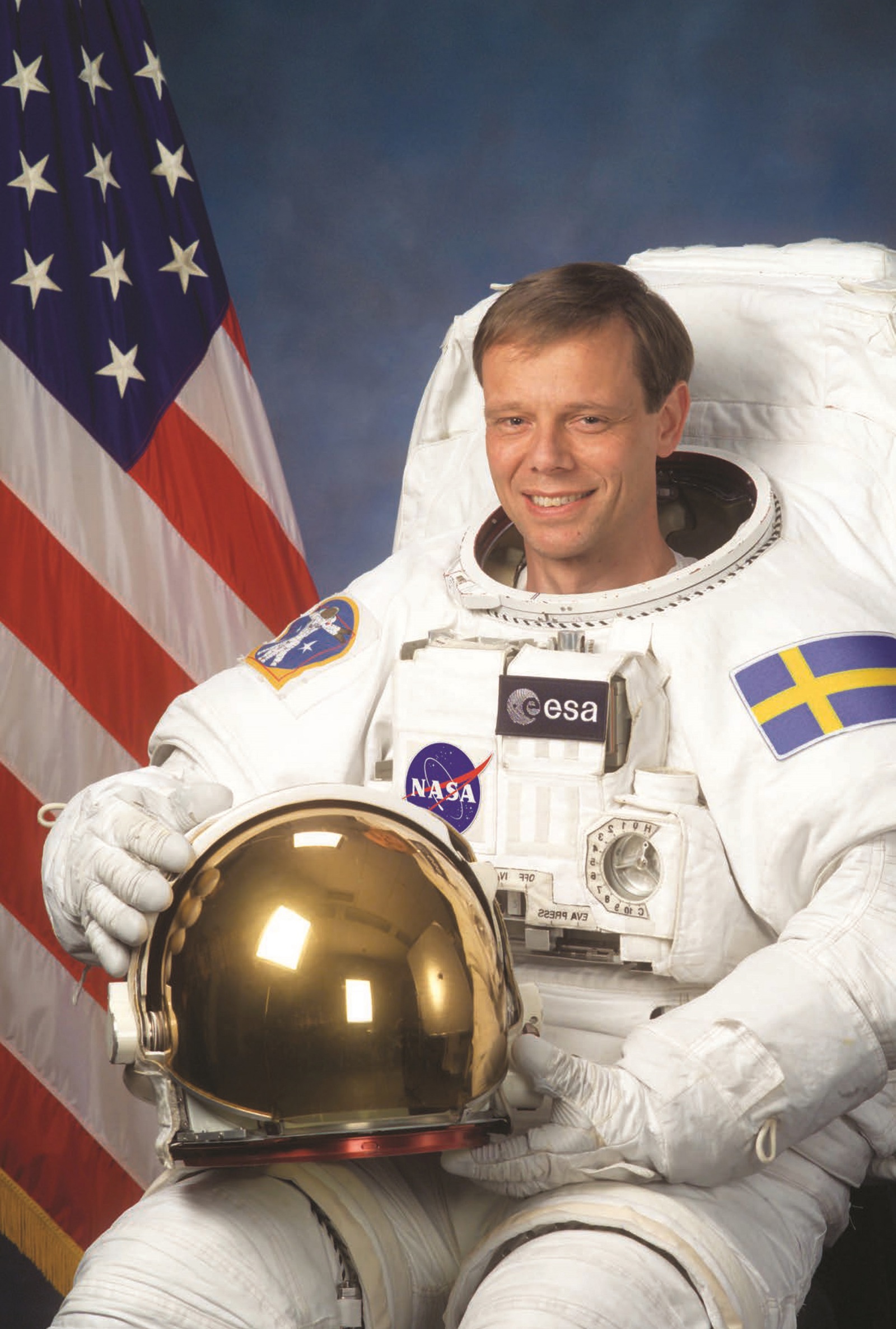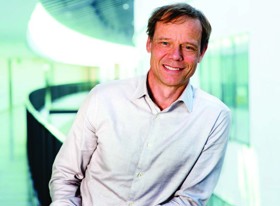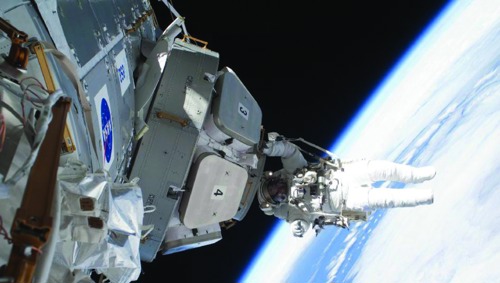
Out of this world class
Christer Fuglesang has dived to the depths and danced with the stars; performing mission critical operations underwater and above the Earth. The Full Picture Magazine blasts off with the acclaimed ESA astronaut for an extraordinary insight into conducting spacewalks, training under pressure and the need for absolute reliability when exploring extremes.
-
Text:Kongsberg Maritime Communication
-
Gunvor Hatling MidtbøVice President, Communications
Christer Fuglesang stood alone: outside, in space, perched on the very top of the International Space Station, travelling at a speed of almost 28,000km/h. The smile that dawns across his face as he describes that experience lights up the room like a solar ray.
“I looked down on this 100m wide structure below me, and far, far beneath that, the clouds, oceans and outlines of continents silently rolling by. I felt, I don’t know,” he says, shaking his head gently in awed recollection, “like I was standing on the top of a mast, riding this enormous ship right around the world.”
The power of the memory renders him silent for a second. Perhaps he’s struggling to describe the indescribable; what it feels like to be higher than any other living thing, watching the world from an orbital altitude of approximately 360km above sea level. He gives up. Smiles again, shrugs and moves on.
It’s probably, understandably, one of those ‘you had to be there’ experiences.
THE STAR ATTRACTION
Christer Fuglesang has been there. The 56 year old Swedish particle physicist and European Space Agency (ESA) astronaut has conducted two space shuttle missions (the STS-116 in 2006 and STS-128 in 2009), carried out five spacewalks (he was the first astronaut outside the US and Russia to complete more than three) and travelled more than 10million miles with NASA. He has spent almost 27 days in space and 31 hours and 54 minutes on EVAs (extra vehicular activities, the space industry’s name for spacewalks). He, more than almost any other person on this planet, has watched from afar, and knows exactly what it means to explore the extremes.
The Full Picture meets him in his offices at the Royal Institute of Technology (KTH) in Stockholm for a rare insight into the mind of a man that embodies the key KONGSBERG qualities of reliability, determination, innovation and collaboration.
His story is, quite simply, inspirational.
WATCH THIS SPACE
Fuglesang, which appropriately enough for someone destined to fly so high means ‘bird song’ in English, didn’t follow the cliché of dreaming to be an astronaut from an early age. Physics was his first love, along with Frisbee (more on that later), leading to an Engineering Physics Master in 1981 and a PhD in Experimental Particle Physics in 1987. From here he quickly moved on to arguably the pinnacle of any scientific career by obtaining a position with CERN, initially working on the CPLEAR project before beginning preparations for the ATLAS experiment at the Large Hadron Collider. This, for the uninitiated, is the world’s largest ever experiment (still on-going), with an international team of thousands searching for the elusive Higgs Boson, or God Particle as it’s more commonly known, by recreating the conditions found in the immediate aftermath of the Big Bang.
He loved space, was interested in going – “well, I like to travel” he explains, with what is fast becoming a trademark smile – but it was something of a distant pipe dream, rather than a realistic objective. Until 1990 that is, when a friend jokingly handed him an advert from a newspaper, noting ‘I think I’ve found you a new job’.
Surprisingly this ‘situations vacant’ ad was for ESA astronauts. What started out as a bit of fun, rapidly progressed to a serious application (he was one of over 300 applicants from Sweden), a selection process at ESA with 65 international hopefuls, and an eventual trainee position at the agency as part of a final intake of six.
Fuglesang had begun a journey that would see him attain a Space Shuttle Mission Specialist role in 1996, his first seat on Discovery ten years later and a place in the record books forever, as the first Swede, in fact the first Scandinavian, in outer space.
“From that point,” he imparts, “I had a new goal – I wanted to spacewalk.”

“Each spacewalk is replicated in underwater conditions first. The pool contains full scale models of relevant sections of the International Space Station” - Christer Fuglesang European Space Agency astronaut

FROM UNDERWATER TO OUTER SPACE
It’s the extensive spacewalk experience that really sets Fuglesang apart, and what has attracted The Full Picture to him today. Specifically, the connection between subsea diving operations and EVAs is of key interest, and something that he himself is quick to acknowledge. The similarities start from the outset.
“Each spacewalk is replicated in underwater conditions first,” he explains, referring to what is called The Neutral Buoyancy Laboratory near the Johnson Space Centre in Houston, home to the world’s largest indoor swimming pool (measuring 62m by 31m, with a depth of 12m).
“The pool contains full scale models of relevant sections of the International Space Station (ISS),” the destination of both his Discovery expeditions and all five spacewalks, he clarifies. “We use these to practice the duties we will conduct on the EVAs. Each astronaut that will undertake an EVA does this, wearing exact copies of our spacesuits, only modified for use in the water. The suits are balanced so we don’t float up or sink down, creating a very similar sensation to weightlessness.
“The duration of the time we spend underwater is roughly the same as a spacewalk, about six hours. Depending on the difficulty and criticality of the spacewalk it will be rehearsed as a mock EVA between three and seven times, so we know the operations pretty much by heart. During this time we are in constant communication with a designated team member sat in a control room beside the pool. That’s the same person that will be our main point of contact in space – they will be sat in the shuttle while we conduct the EVAs. The reliability and clarity of communication between us is absolutely fundamental to the success of the EVA.”
In the same way as the subsea diver is the very ‘tip of the tool’ – with all the other operational components, including the team in the DSV (dive support vessel) and those in the diving bell, feeding expertise and real-time information to ‘the hand’ conducting the assignment – so is the astronaut. In his, or her, case they are supported by the team in Mission Control, observing from a live video stream captured via a helmet top camera, and the immediate support person in the shuttle, taking the astronaut through the EVA step-by-step.
Fuglesang even says that the sensation of walking in space is somewhat akin to diving, with the mutually existing yet contradictory feelings of constraint “within the somewhat clumsy suit” married to an “incredible freedom” as you’re operating at the very extreme limits of human understanding, with full responsibility for mission critical tasks.
“It was great - a privilege,” he surmises, as his thoughts seemingly wonder back up to the ISS, which has now surpassed Mir’s record for the longest constantly inhabited space station (first occupied back in 2000).
FEELING THE PRESSURE
The similarities with diving continue. Both astronauts and divers are in danger from the dreaded ‘bends’ (a condition whereby dissolved gases come out of solution into bubbles inside the body as a result of depressurisation) with both therefore having to take precautions, although at different junctures. Divers enter decompression chambers post-dive, whereas astronauts conducting EVA’s utilise them pre-spacewalk, as the pressure drops on their assignments.
The pressure inside a spacesuit is, Fuglesang remarks, only a third of standard atmospheric pressure. He and his fellow EVA astronauts – every EVA features two individuals for safety reasons – entered into a pressurised airlock the day before the spacewalks to acclimatise, conducting equipment checks and even sleeping there prior to exiting the space station.
“It was actually a very positive experience, meditative rather than stressful,” he reveals, before revealing a little bit too much with a story about the lack of toilets in airlocks and the need for nappies. We’ll leave that story there.
While divers are connected to diving bells with umbilical cords, astronauts have tethers securing not just themselves, but also all their equipment and tools, to avoid them floating frustratingly, and dangerously, out of reach. These are prone to tangling both under the water and above the atmosphere, and require the requisite, much practiced, expertise and attention to keep them floating freely.
Th is focused attention, this constant sense of awareness – both situational, in terms of positioning on the structure of the space station, and of set duties – is, Fuglesang notes, perhaps the hardest thing about any spacewalk.
“Physically, the strains on the body are not severe, although that depends on the task you’re carrying out,” he says, relaying that on his EVAs, which were primarily maintenance and construction related, there was the occasional need to break sweat to free up bolts etc. “However, mentally it is exhausting. You are out there for six hours, in an extremely high-pressured environment, with a whole world watching you, while you’re conducting a task that could be, in some cases, the highpoint of your career and training. It is very intense,” he opines, with a degree of understatement.

Home base: The ISS, which orbits the Earth approximately every 90 minutes, has been constantly inhabited by teams of astronauts since 2000. Photo: NASA
UNPLANNED SUCCESS
Fuglesang is candid when describing his three EVAs on the STS-116 mission and the two that followed on STS-128 three years later. Naturally, he says, he is of a creative disposition, relishing the challenges of problem solving, so being told exactly what to do – both by Mission Control and his colleague on the Shuttle – was not (perhaps) an ideal scenario. However, when describing his third EVA in 2006 that solar ray smile illuminates once again.
“That was unplanned,” Fuglesang beams, meaning there was no time to take a dip in the pool for practice.
“A solar panel on the space station hadn’t retracted properly, it was supposed to do that by electrical command, so we (Fuglesang and experienced US astronaut Bob Curbeam) had to go out to try and fix the problem. We were thinking on the spot, with tools that we’d basically put together ourselves, in the airlock, from the existing tools we had. There was much greater independence, but the key to the success was the communication between all parties – us, the shuttle and Mission Control – suggesting solutions, advising us where possible, as we tried, step-by-step, to retract this piece of equipment.”
It was an ad-hoc task that, after six hours and 38 minutes of activity outside the ISS, was a complete success.
“That was even more fun than the others,” Fuglesang exclaims.
TAKING FLIGHT
This Full Picture interviewee is a special breed of human being that has reached the heights, both figuratively and literally, in an unquestionably stellar career. But he has also retained a sense of fun and is obviously passionate about communicating the benefits of scientific exploration to new generations (although still employed by ESA he is now running a Masters programme in Aerospace at KTH and will launch a course christened ‘Human Space Flight’ as part of that proposition next year). This was clear when, on his first shuttle mission, he achieved a new ‘galactic record’.
In a bid to demonstrate the concept of weightlessness to those trapped by the Earth’s gravitational forces, Fuglesang took a Frisbee into space. A Swedish national Frisbee champion in his youth, he spun the disc in the microgravity conditions of the ISS to replicate a record he set in 1978 for ‘maximum time aloft’ (the time a Frisbee stays airborne between throw and catch). His new record of 20 seconds smashed the previous best and was recognised by the World Flying Disc Federation as a record, albeit it a ‘galactic’ one.
“It was just something personal,” he muses, “an idea to help connect the space mission with a broader audience. That was fun too.”
Which goes to show that Christer Fuglesang, no matter if he’s riding the ISS 400km above the earth or playing Frisbee with fellow astronauts, is probably one of the most down to earth astronauts you could ever hope to meet.